Friday, January 22. 2010
Have I cracked the the telepresence conundrum?
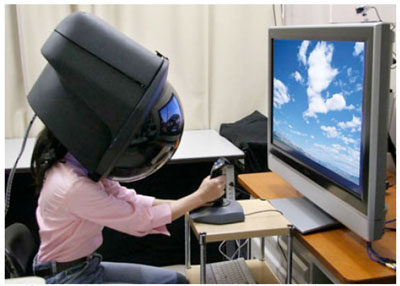
Last evening I particpated remotely from my home in France in a pre-event in Amsterdam of ElectroSmog International Festival for Sustainable Immobility.
I didn't use the fancy gadget in the photo above. My set-up yesterday was a bit, but not a lot, better-organized than the remote recording session (below) I did for a BBC radio programme last summer.
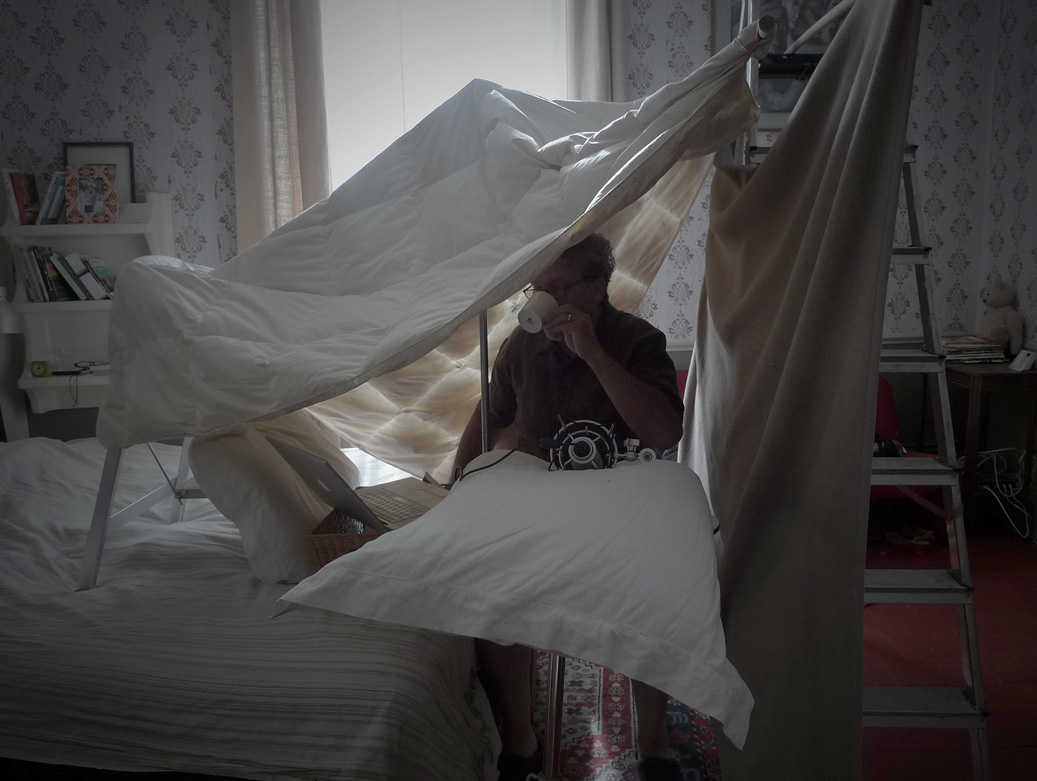
I said my bit to deBalie via skype, and followed the rest of proceedings, which were chaired by Eric Kluitenberg, on deBalie's livestreaming feed.
The deBalie session was not, I know, a major event in the greater context of events concerning sustainability, media, and design. But I'm proud, nonetheless: I have not yet set foot in an aeroplane in 2010, and this event was a meaningful first step: it followed a new year resolution radically to reduce my work-related travel.
In preparing for yesterday's modest exercise, I was amazed to discover that I have been writing about the substitution of telepresence for mobility for seventeen years. Writing, not doing, I know: By no means all my texts and talks are here and here and here and here and here and here and here and here and here and here and here and here and here and here and here and here.
Although deBalie's streaming video feed was clear (thanks to their industrial-quality cameras; three-times normal bandwidth; something called an h264 video codec; and Gerbrand); and Eric was a clear and well-organized compere; but the experience was as unrelaxing, experientially, as always.
I spent half-a-day spent fidding with lights and backdrops at my end. I had to miss lunch in order to test skype. And I had to work hard, during the event itself, to keep track of what was happening in Amsterdam. An abruptly broken connection, internet-side, just as the final Q+A started, was an abrupt but unsurprising conclusion.
Content-wise, the session was a blast from the past - in good ways and bad.
A guy from IBM demo'd a hideous virtual "creative office" populated by avatars. The avatar representing the IBM-er in Belgium failed to speak or move for five minutes; its human owner had apparently left his desk to look for a beer. This was fair enough -a national beer strike in Belgium has only recently ended - but the jerky, implausible look-and-feel of IBM's virtual office was less enticing than the pre-Sims demo given by Will Wright at Doors of Perception back in 1998.
(It wasn't much better, either, than the time I did a video conference with Korea in which twelve corporate persons - not from IBM - sat in a row facing the camera. I was able scan the camera along the line, jerkily, from my end. But because my fellow videoconferencers were dressed in identical blue suits, white shirt and dark tie; and because most of them seemed to be called Mr Kim; I soon gave up).
(But last night's IBM demo was superior to the videoconference between a summer school in Lisbon, and the White House, that I experienced last summer. Then, the link was enabled by Cisco Systems' ultra high-end platform. We were all excited because our interviewee was said to have an office just down the hall from the Oval Office. We all assumed that communicating with the centre of world power on the world's fanciest videoconferencing platform would be fab. But the link, once opened, yielded sound and pictures worse then the ones sent back by the first lunar lander. After ten minutes of torture, someone in Lisbon put their hand up and said" "can't we use skype?" - so we we did).
But there were delights, last evening, too. Costas Bissas from DistanceLab told us, from a location somewhere in the wilds of Scotland, about a cow called Grace who has been fitted with a webcam.

It took me back to the time Bill Gaver and Tony Dunne attached web-enabled microphones to chickens in Peccioli.
I told Costas I would pay good money to see Grace charging a bunch of tourists, but he said that is not their business model.
As last night's discussion continued, I had an epiphany: it is not my job to keep track of all these tele-tools and platforms - still less, to set them up and make them work when I need them.
I thought back to the early years of the telephone: for decades after the telephone was first publicly deployed, one would pick up the receiver - and a room full of operators would make the connection for you.

This is what we need now. We need the equivalent of a roadie for telepresence events.
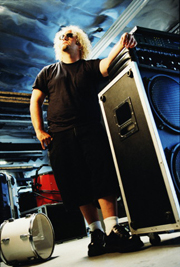
Rock stars don't have to fiddle about setting up amps and lighting and the stage before they perform - so why should I, or any other right thinking citizen who has a life to lead?
e-Roadies are the solution I have been searching for for seventeen years.
I haven't worked out where to find them, nor how to train them - still less, a business model to pay for them. But I am surely on the right track because E-Roadies are a human solution.
Posted by John Thackara at January 22, 2010 10:35 AM
-----
Facebook’s Privacy Push: Right Move, Wrong Time? [OPINION]
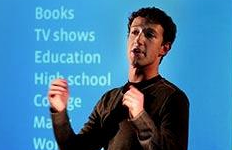
Facebook’s new approach to privacy is bold, pushing users to be increasingly public with their data.
This public sharing is the new “social norm”, said founder Mark Zuckerberg in a recent interview. But is Facebook really responding to cultural changes or simply encouraging the type of behavior that will help the company to grow fastest? Possibly both.
That’s the topic of my guest column today in the UK’s Telegraph newspaper.
Read the full column on The Telegraph
"Facebook's privacy changes: the real reason behind the move
Is it a coincidence that less privacy for users means more money for Facebook?"
>>
"Facebook's privacy changes: the real reason behind the move
Is it a coincidence that less privacy for users means more money for Facebook?"
-----
Via Mashable
Glacier / Island / Storm
The past week has been particularly busy, as everything behind the scenes here has been geared entirely toward the launch, later today, of two courses I'll be teaching this spring in New York City: a research seminar on blackouts at the Pratt Institute in Brooklyn and a design studio up at Columbia's Graduate School of Architecture, Planning and Preservation.
Both of these courses will be the subject of updates now and again here on the blog over the next few months, but I thought, for now, that it'd be fun simply to put my Columbia course description & design brief up to start that ball rolling.

[Image: Photo via the Alfred Wegener Institute].
The purpose of this studio is to look at naturally occurring processes and forms—specifically, glaciers, islands, and storms—and to ask how these might be subject to architectural re-design. We will begin our investigations by looking at three specific case-studies, including the practical techniques and concerns behind each. This research will then serve as the basis from which studio participants will create original glacier/island/storm design proposals.

GLACIER: For centuries, a vernacular tradition of constructing artificial glaciers in the Himalayas has been used to create reserves of ice from which freshwater can be reliably obtained during dry years. This is the glacier as non-electrical ice reserve, in other words; some of these structures have even received funding as international relief projects—for instance, by the Aga Khan Rural Support Program in Pakistan. Interestingly, the artificial glacier here becomes a philanthropic pursuit, falling somewhere between Architecture For Humanity and a sustainable water-bank.
Through an examination of glacier-building techniques, water requirements, and the thermal behavior of ice, we will both refine and re-imagine designs for self-sustaining artificial glaciers, structures made without the use of fossil fuels and for the purpose of storing fresh water.
But what specific tools and spatial techniques might this require? Further, what purposes beyond drought relief might an artificial glacier serve? There are myths, for instance, of Himalayan villagers building artificial glaciers to protect themselves against invasion, and perhaps we might even speculate that water shortages in Los Angeles could be relieved with a series of artificial glaciers maintained by the city’s Department of Water and Power at the headwaters of the Colorado River…
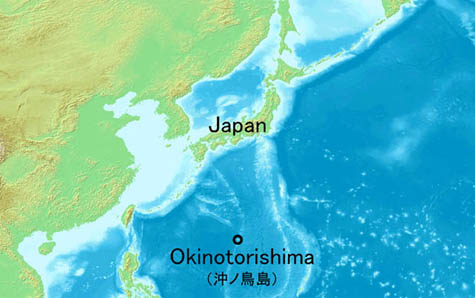
ISLAND: Building artificial islands using only sand and fill is relatively simple, but how might such structures be organically grown?
In the ocean south of Japan is a complex of reefs just slightly below the surface of the water; Japan claims that these reefs are, in fact, islands. This is no minor distinction: if the international community supports this claim, Japan would not only massively extend its Exclusive Economic Zone (EEZ), complete with seabed-mining and fishing rights, but it would also block China from accessing those same resources. This would, however, also limit the ability of Chinese warships to patrol the region—and so the U.S. has publicly backed Japan's territorial claim (China does not).
Okinawan scientists have thus been developing genetically-modified species of coral with the express idea of using these species to “grow” the reefs into a small but internationally recognized archipelago: the Okinotori Islands. Think of it as bio-technology put to use in the context of international sovereignty and the U.N. Law of the Sea.
The stakes are high—but, our studio will ask, by way of studying multiple forms of reef-building as well as materials such as Biorock™, where might other such island-growing operations be politically and environmentally useful? Further, how might the resulting landforms be most interestingly designed?
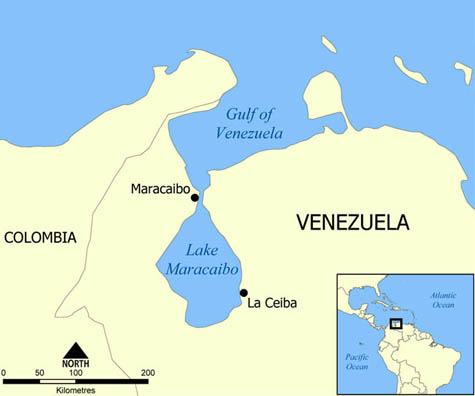
STORM: For hundreds of years, a lightning storm called the Relampago del Catatumbo has flashed in the sky above Venezuela’s coastal Lake Maracaibo. The perfect mix of riverine topography, lake-borne humidity, and rain forest air currents has produced what can be described, with only slight exaggeration, as a permanent storm.
This already fascinating anecdote from the natural world takes on interesting spatial design implications when we read, for instance, that Shanghai city officials have expressed alarm at the inadvertent amplification of wind speeds through their city as more and more skyscrapers are erected there—demonstrating that architecture sometimes has violent climatological effects. Further, Beijing and Moscow both have recently declared urban weather control as an explicit aim of their respective municipal governments—but who will be in charge of designing this new weather, and what role might architects and landscape architects play?
We will be putting these—and many other—examples of weather control together with urban, architectural, and landscape design studies in an attempt to produce atmospheric events. For instance, could we redesign Manhattan's skyline to create a permanent storm over the city—or could we rid the five boroughs of storms altogether? And under what circumstances—drought-relief in the American southwest or Gulf Coast hurricane-deflection—might our efforts be most practically useful?
The studio will be divided into three groups—one designing glaciers, one designing islands, one designing storms. Each group will mix vernacular, non-fossil fuel-based building technologies with what sounds like science fiction in order to explore the fine line between architectural design and the amplified cultivation of natural processes. Importantly, this will be done not simply for the sake of doing so (although there will be a bit of that…), but to address much larger questions of regional drought, international sovereignty, global climate change, and more.
Required readings include the specially assembled coursepack and associated PDFs, and there will be a handful of screenings, one or two studio visits by experts in these fields, and a few other collaborative online resources yet to be announced.
------
Via BLDGBLOG
Rebooting Britain: Transform cities into lush jungles
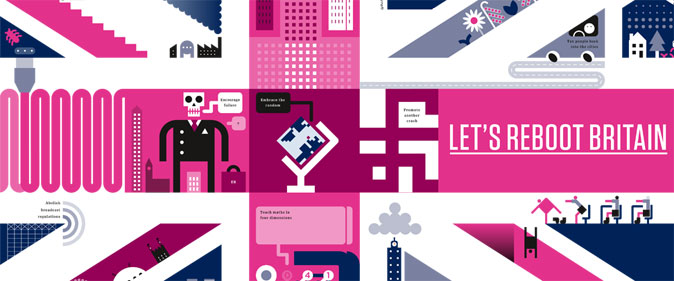
Photo: Peter Grundy
This article was taken from the January issue of Wired UK magazine. Be the first to read Wired's articles in print before they're posted online, and get your hands on loads of additional content by subscribing online
Cities may be more energy-efficient than the countryside, but we can radically enhance that efficiency with existing and achievable technology plus a little imagination, making cities carbon neutral and all but self-sufficient.
Here's a four-step plan:
1 Build intelligently Construction of new buildings consumes materials and creates massive carbon debt. Wherever possible, existing stock should be refurbished and retrofitted using bioarchitectural techniques and recycled and sustainable materials to enhance energy conservation, reduce water consumption, and maximise use of rainwater. Turn office buildings into the equivalent of high-tech beehives; shopping malls into jungle bazaars; point blocks into pinnacles dripping with vines and pocket forests.
2 Go Nuclear Present experience shows sustainable sources of energy - from buildings equipped with solar panels and wind generators to plants generating biofuel and electricity by digesting garbage - will not satisfy the energy demands of large cities. A new generation of compact long-life nuclear power plants such as India's thorium reactor or South Africa's pebble-bed design will plug the power gap and produce small quantities of waste that, unlike carbon dioxide generated by oil- and coal-fired plants, can be safely stored in vitrified form.
3 Stop using fossil fuels Cities are at present vulnerable to the smallest interruptions in oil and gas supply. The first step in cutting this dependency should be a ban on private car ownership in metropolitan areas. Even a sprawling city like London can be comfortably navigated by walking, cycling, and use of public transport - powered, like delivery vehicles servicing businesses and homes, by batteries, biofuels, or hydrogen fuel cells. The great tidal flows of commuters could be reduced by rezoning commercial areas for residential use and introducing workshops and offices into residential areas, as in the human-scale, mixed-use street plans of medieval cities.
At present, 30 per cent of London's carbon budget is consumed by commercial aircraft flights. In the future, all flights should use only biofuels produced by farming GM microalgae that mop up nutrients from sewage and produce ethanol and lipids. Even without genetic modification some strains of algae already yield more than ten to 20 times more biodiesel than rapeseed; the most efficient grow in saltwater, so would not compete for potable water; and fuel production powered by photosynthesis would be carbon neutral.
4 Embrace GM Parking structures and unwanted office and residential tower blocks could be converted to vertical farms where high-value GM crops, produced by open-source research rather than agribusiness, modified for perennial growth and maximum productivity, could be grown year-round using advanced hydroponics systems (drug dealers have already embraced this technology to produce crops of GM marijuana in ordinary houses). Walls and streets would be turfed with tough GM grasses and sedges; these, and thick plantings of trees lining roads, would absorb carbon dioxide and provide equitable microclimates.
From the air, the ideal green city should resemble Mayan ruins poking out of a lush forest. Under the canopy, there'll be densely populated but diverse and vibrant streets humming with every kind of human life. Utopian? You bet. But unless we get a lot smarter very quickly, we'll get the future we deserve: sweltering resource-poor mega-favelas salted with the high-security enclaves of the hyper-rich. Time to choose.
Paul McAuley is a biologist and multi-award-winning science-fiction author. His new novel Gardens of the Sun is published by Gollancz.
Read other articles from the Rebooting Britain series
- Tax people back into the cities
- Teach kids to see in four dimensions
- Exercise a green foreign policy
- Open democracy to the online masses
- Reinvent the way we live together
- Live life as a lottery
- Pull the plug on broadcast regulation
- Enact beta versions of new laws
- Make carbon emissions hurt
- Slash the universities and go virtual
- Make policy using prediction markets
- Promote another crash
- Ditch Twitter: it's dangerous for democracy
- Encourage failure
- Make education more flexible
- Set government data (radically) free
Want more Wired UK magazine? Get your copy every month by subscribing online today
-----
Via Wired UK
Edible Schoolyard / Work AC
Work AC, in collaboration with Edible Schoolyard NY and the Alice Waters’ Chez Panisse Foundation, is designing a new schoolyard for PS216 that will offer the young New Yorkers a different learning experience. The Edible Schoolyard is designed as a series of interlinked sustainable systems where the building will produce energy and heat, collect rainwater, process compost and sort waste with an off-grid infrastructure.
More images and more about the school after the break.
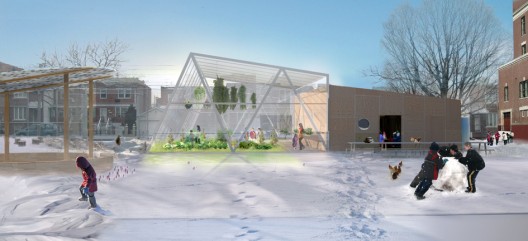
The school includes a kitchen classroom and mobile greenhouse where children are brought together in a learning environment that also promotes eco-friendliness. The roof of the kitchen classroom, a room that provides the facilities for up to 30 students to prepare meals together, channels rain water for reclamation. The mobile greenhouse extends the growing season by covering 1600sf of soil in the colder months and gardens will allow the children to care for plants.
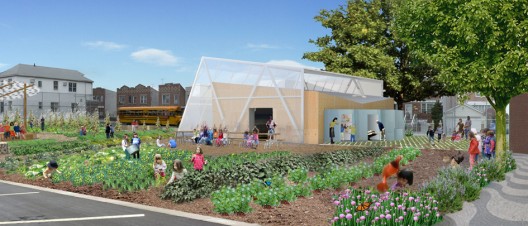
A systems wall, a series of spaces that include a cistern, space for composting and waste-sorting, solar batteries, dishwashing facilities, a tool shed and a chicken coop, rests on the opposite side of the yard.
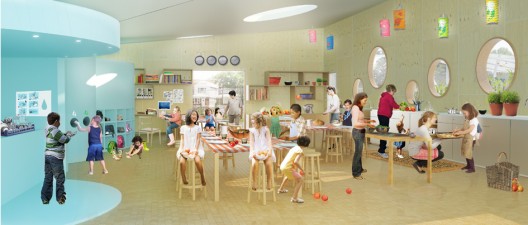
The project is a great way to introduce sustainable methods into children’s lives at an early age. The “edible” element will definitely pique children’s interests and help the next generation realize the importance of the eco-friendly movement.
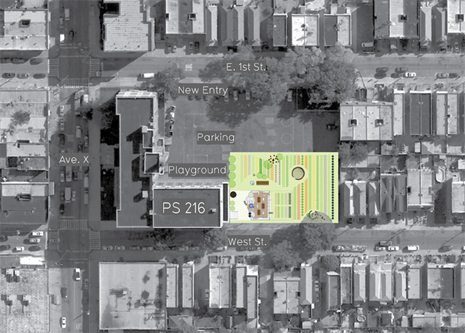
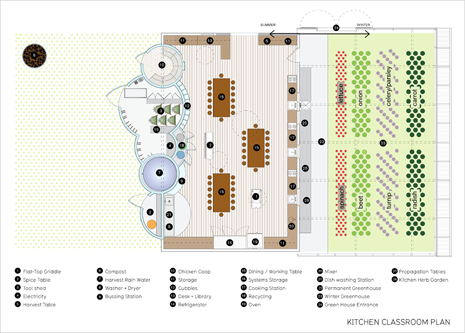


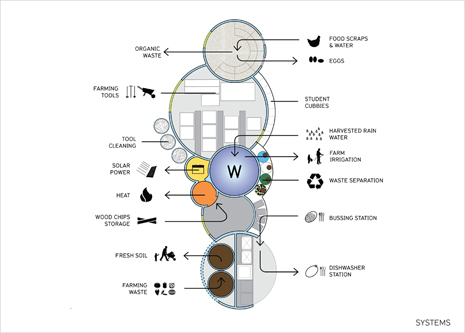
All images courtesy of WORKac
-----
Via ArchDaily
Related Links:
fabric | rblg
This blog is the survey website of fabric | ch - studio for architecture, interaction and research.
We curate and reblog articles, researches, writings, exhibitions and projects that we notice and find interesting during our everyday practice and readings.
Most articles concern the intertwined fields of architecture, territory, art, interaction design, thinking and science. From time to time, we also publish documentation about our own work and research, immersed among these related resources and inspirations.
This website is used by fabric | ch as archive, references and resources. It is shared with all those interested in the same topics as we are, in the hope that they will also find valuable references and content in it.

